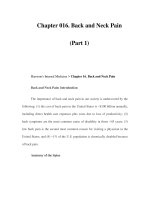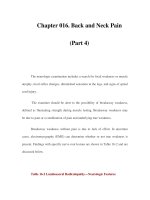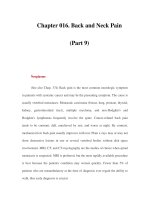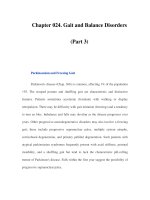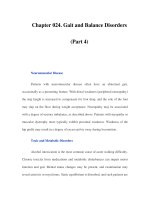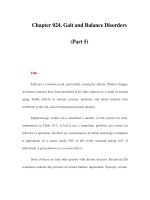Chapter 024. Gait and Balance Disorders (Part 1) docx
Bạn đang xem bản rút gọn của tài liệu. Xem và tải ngay bản đầy đủ của tài liệu tại đây (11.64 KB, 5 trang )
Chapter 024. Gait and Balance Disorders
(Part 1)
Harrison's Internal Medicine > Chapter 24. Gait and Balance Disorders
Prevalence, Morbidity, and Mortality
Gait and balance problems are common in the elderly and contribute to the
risk of falls and injury. Gait disorders have been described in 15% of individuals
over the age of 65. By age 80, one person in four will use a mechanical aid to
assist ambulation.
Among those 85 and older, the prevalence of gait abnormality approaches
40%. In epidemiologic studies, gait disorders are consistently identified as a major
risk factor for falls and injury.
A substantial number of older persons report insecure balance and
experience falls and fear of falling. Prospective studies indicate that 20–30% of
those over age 65 fall each year, and the proportion is even higher in hospitalized
elderly and nursing home patients. Each year 8% of individuals >75 suffer a
serious fall-related injury. Hip fractures often result in hospitalization and nursing
home admission.
For each person who is physically disabled, there are others whose
functional independence is constrained by anxiety and fear of falling. Nearly one
in five of elderly individuals voluntarily limit their activity because of fear of
falling. With loss of ambulation, there is a diminished quality of life and increased
morbidity and mortality.
Anatomy and Physiology
Upright bipedal gait depends on the successful integration of postural
control and locomotion. These functions are widely distributed in the central
nervous system.
The biomechanics of bipedal walking are complex, and the performance is
easily compromised by injury at any level. Command and control centers in the
brainstem, cerebellum, and forebrain modify the action of spinal pattern generators
to promote stepping.
While a form of "fictive locomotion" can be elicited from quadrupedal
animals after spinal transection, this capacity is limited in primates. Step
generation in primates is dependent on locomotor centers in the pontine
tegmentum, midbrain, and subthalamic region. Locomotor synergies are executed
through the reticular formation and descending pathways in the ventromedial
spinal cord.
Cerebral control provides a goal and purpose for walking and is involved in
avoidance of obstacles and adaptation of locomotor programs to context and
terrain.
Postural control requires the maintenance of the center of mass over the
base of support through the gait cycle. Unconscious postural adjustments maintain
standing balance: long latency responses are measurable in the leg muscles,
beginning 110 ms after a perturbation.
Forward motion of the center of mass provides propulsive force for
stepping, but failure to maintain the center of mass within stability limits results in
falls.
The anatomic substrate for dynamic balance has not been well defined, but
the vestibular nucleus and midline cerebellum contribute to balance control in
animals. Human patients with damage to these structures have impaired balance
with standing and walking.
Standing balance depends on good quality sensory information about the
position of the body center with respect to the environment, support surface, and
gravitational forces.
Sensory information for postural control is primarily generated by the
visual system, the vestibular system, and by proprioceptive receptors in the muscle
spindles and joints. A healthy redundancy of sensory afferent information is
generally available, but loss of two of the three pathways is sufficient to
compromise standing balance.
Balance disorders in older individuals sometimes result from multiple
insults in the peripheral sensory systems (e.g., visual loss, vestibular deficit,
peripheral neuropathy), critically degrading the quality of afferent information
needed for balance stability.
Older patients with mental status abnormalities and dementia from
neurodegenerative diseases appear to be particularly prone to falls and injury.
Frailty, muscle weakness, and deconditioning undoubtedly contribute to the risk.
There is a growing literature on the use of attentional resources to manage
locomotion.
The ability to walk while attending to a cognitive task (dual tasking) may
be particularly compromised in older adults with a history of falls. Walking is
generally considered to be unconscious and automatic, but older patients with
deficits in executive function may be unable to manage the attention needed for
dynamic balance when distracted.



